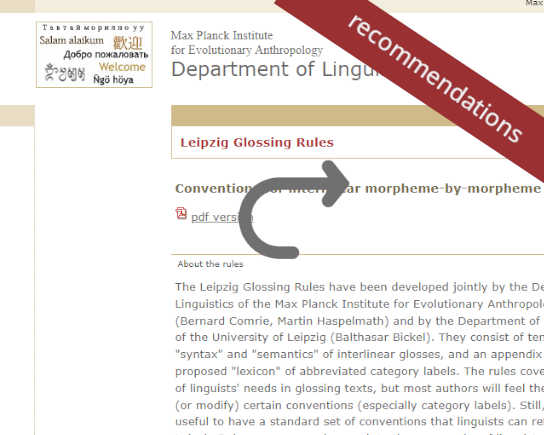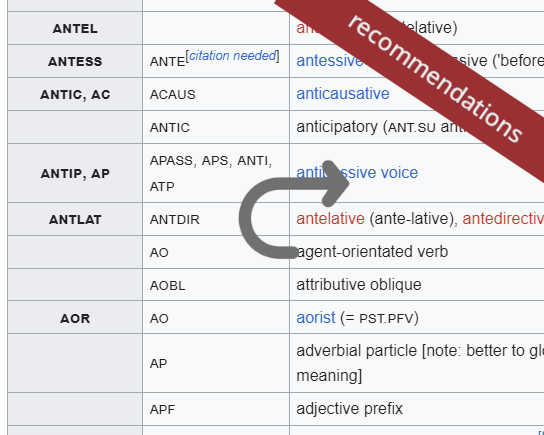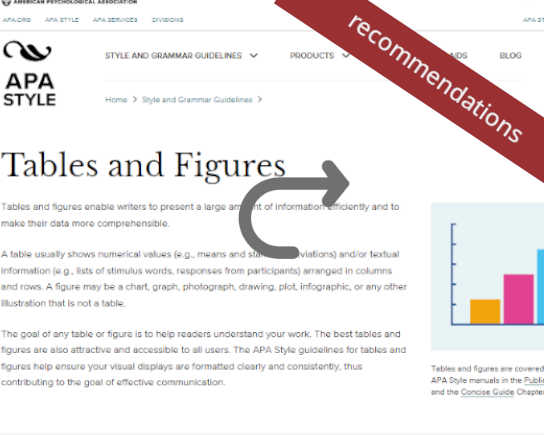Conception
how to organize a linguistic paper
introduction
Goal
to describe a phenomenon, to test a research question, to propose or refine a theoretical statement.Relevance
the goal of the study should promise a contribution to prior knowledge, which has been created by a research paradigm. Establishing the scientific relevance implies a short outline of the prior knowledge (with bibliographical references).Outline
how the present study will reach this goal: this is typically an outline of the sections in the last paragraph accompanied with cross-references.
There many ways to explain the goal to the readers. A strategy is to introduce a puzzle with core examples, another strategy is to introduce a debate between accounts.
The personal relevance, e.g., motivation through the course contents, personal interests, credits and further aspects that are not relevant for the eternity do not have place in a term paper
main body
depending on the goal of the study:
describing a phenomenon
The contents of the study may reflect the structure of the phenomenon. For example:
2. Number categories
2.1. General
2.2. Singular
2.3. Plural
2.4. Dual
3. Number expressions
3.1. Noun phrase
3.2. Verb agreement
You may consult the International Journal of American Lingustics for examples.
examining a research question
Empirical studies (e.g., corpus studies, linguistic experiments in psycholinguistics, phonetics, experimental syntax) introduce a research question in the introduction.
2. Method
participants, materials, procedure, data analysis
3. Results
describing the obtained data
4. Discussion
interpreting the results
You may consult Cognition, the International Journal of Corpus linguistics or Journal of Phonetics, depending on your research focus.
proposing/refining a theory
Theoretical studies (e.g., in syntax, semantics, phonology) often propose an analysis within a certain framework.
2. Theoretical background
introduces the theoretical assumptions needed and alternative analyses in earlier research
3. Facts
describing the relevant data; with as few assumptions as possible
4. Analysis
presenting the analytical proposal in detail
You may consult Natural Language and Linguistic Theory for examples.
conclusions
Summary
outline of the basic questions, facts, and inferences from the facts.Contribution
how does this study contribute to the available knowledge (with reference to earlier studies)Scaling up
generalizability for other phenomena or languages, new questions opened by the investigation
Empirical aspects
how to treat the data
linguistic data
Linguistic data from different languages should be presented in an accessible format for readers. Linguistic publications use interlinearly glossed examples:
- line 1: orthographic or phonological representation, with morphemic transcription
- line 2: morpheme-by-morpheme translation, including abbreviations for glosses (labels for grammatical categories), aligned with the corresponding elements in the transcription layer
- line 3: sentence-by-sentence translation (also called "free translation"), accompanied by a citation of the source in parenthesis

reporting methods and facts
General recommendations:
- Precision about the source of the data (collaboration with native speakers, samples of participants in experiments)
- Details about the method of data gathering: documenting the methods including examples (e.g., illustrative stimuli)
- Single examples: each example should be sufficiently explained in the running text; use as many examples you need for the argumentation and discuss their relevance
- Aggregated data: use tables and figures reporting the data, avoid distracting graphical devices and do not plot more than one figure with the same data. Consider the APA Guidelines for tables and figures (s. below)
Analytical aspects
how to increase the analytical clarity
- Introduce the necessary assumptions and theoretical framework of the study (this can be part of a section devoted to the theoretical background). To maximize coherence, the outline of the background should not look like an encyclopedic review, but it should be restricted to the relevant issues for the main body of the study.
- Critical view: what are the gaps that earlier theories fail to explain? What are the different predictions of alternative theories?
- Terminology: use terminology consistently, providing clear definitions for the terms that are not obvious for every reader in linguistics.
- Add formal representations (e.g., trees, OT-tables, logical forms) effectively, accompanied with clear explanations.
Prior Knowledge
how to deal with earlier research
- The relevance of the research goal and the inferences from the data should be related to the earlier research.
- References to earlier research should be integrated to the argumentation: in general, we refer to statements and we cite the source of the statements.
- Bibliographical references are listed in a section "References" (not in footnotes) containing all and only bibliographical references that are cited in the running text.
- For the form of citations and bibliographical references, use the professional standards of the respective research paradigm:
- papers in general linguistics: Generic Style Rules for Linguistics.
- papers reporting experiments or empirical studies: the APA Style.
- References should be scientific sources, such as peer-reviewed articles and books that report research and have undergone a scientific quality review process. General sources like Wikipedia or blogs are not appropriate - such sources can be cited if they provide relevant information that cannot be found elsewhere.
Styles
how to create a professional layout
General recommendations:
- Sections
- must be hierarchically numbered
- subsections (1.1.) and subsubsections (1.1.1.) are alright; subsections beyond the third layer are old-fashioned.
- a subsection needs always a sister subsection: i.e., you cannot have subsection 2.1. if there is no subsection 2.2 (this is called a "lone subsection" or an "orphan subsection" in typography)
- Footnotes
- must be used sparingly
- do not contain more than a paragraph (which entails that they cannot contain interlinear examples)
- Captions
- tables and figures must have a number (Table 1, Table 2, etc.) and a caption.
- tables and figures must be cross-referred in the running text (e.g., "see Table 2").
- Examples
- must be numbered.
- examples must be cross-referred in the running text (e.g., "see (2)").
Familiarizing with the author guidelines of linguistic publishers is an essential aspect of your professional development. The most effective approach is to use the stylesheet of a journal relevant to the field of your term paper or thesis.
- various journals in general and historical linguistics (e.g., "Linguistics", "Zeitschrift für Sprachwissenschaft", "Indogermanische Forschungen") use the ms submission guidelines for De Gruyter.
- papers in theoretical linguistics may use the submission guidelines of Natural Language and Linguistic Theory.
- for experimental linguistics and empirical studies in general, it will be an asset if you familiarize yourslef with the APA Style.
Otherwise you can just use a simple layout, avoinding distracting format devices:
- font size: 12 pt
- line spacing: 1,5
- headings: level 1 bold, levels 2-3 italics
Further sources
worth considering
- University of Göttingen, English department: Guidelines for Linguistic papers
- University of Göttingen, institute for Linguistics: Guidelines for Linguistic papers
- very rich website with introductions to various publishing standards by the Purdue University
- University of Göttingen, Examination office: guidelines for term papers
- University of Göttingen, Examination office: dealing with AI models


